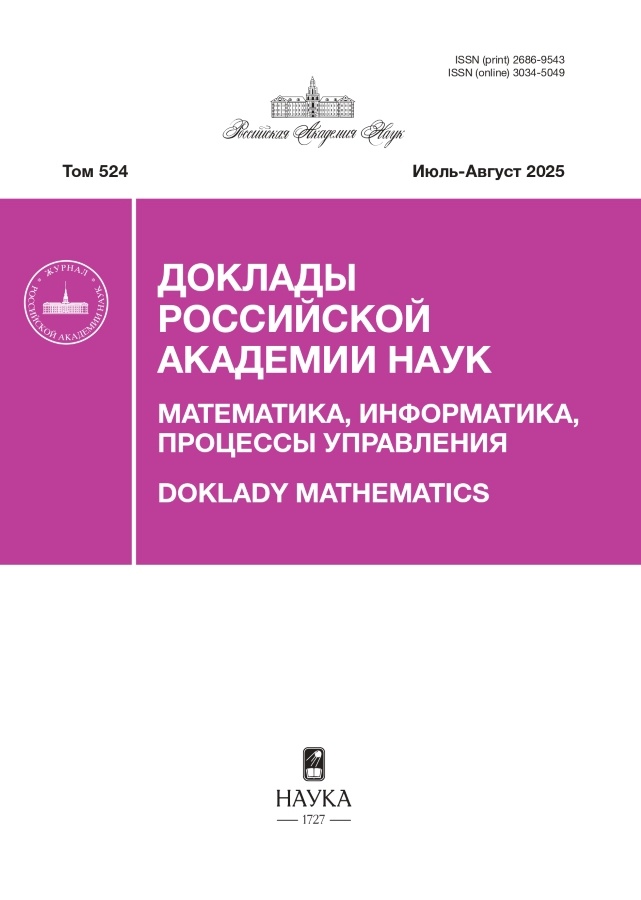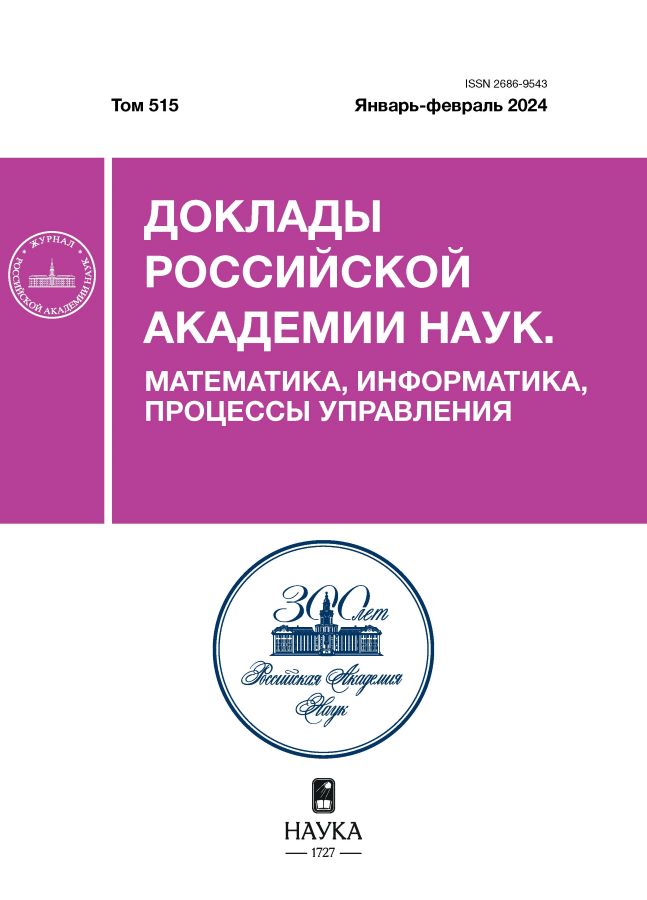Том 515 (2024)
МАТЕМАТИКА
Функции вращения интегрируемых биллиардов как траекторные инварианты
Аннотация
Изучаются траекторные инварианты интегрируемых биллиардов на двумерных столах-книжках при постоянных значениях энергии. Эти инварианты вычисляются по функциям вращения, определенным на однопараметрических семействах 2-торов Лиувилля. Для двумерных биллиардных книжек доказан полный аналог теоремы Лиувилля, введены переменные действие-угол, определены функции вращения. Получена общая формула функций вращения таких систем. Для ряда примеров была исследована монотонность этих функций, вычислены реберные траекторные инварианты (векторы вращения). Оказалось, не все биллиарды обладают монотонными функциями вращения, как изначально предполагала гипотеза А.Т. Фоменко. Тем не менее для некоторых серий биллиардов эта гипотеза верна.
 5-10
5-10


Операторные оценки для задач в областях с сингулярным искривлением границы: условия Дирихле и Неймана
Аннотация
Рассматривается система полулинейных эллиптических уравнений второго порядка в многомерной области, граница которой произвольным образом искривляется и содержится в узком слое вдоль невозмущенной границы. На искривленной границе задается условие Дирихле или условие Неймана. В случае условия Неймана на структуру искривления дополнительно накладываются достаточно естественные и весьма слабые условия. Показано, что в таких предположениях усредненной будет краевая задача для той же системы в невозмущенной области с краевым условием того же типа, что на возмущенной границе. Основной результат – соответствующие операторные - и L-оценки.
 11-17
11-17


Апериодическая изопериметрическая планарная задача усреднения с критическим диаметром: общий нелокальный странный член для динамического одностороннего граничного условия
Аннотация
В статье изучено асимптотическое поведение решения уравнения диффузии в плоской области, перфорированной мелкими множествами разной формы, имеющими постоянный периметр и диаметр которых равномерно ограничен, в случае, когда расстояние между частицами ε стремится к 0. Так как частицы имеют разную форму, то в общем структура области апериодична. На границе выбрасываемых включений (или частиц, как в химической инженерии) поставлены динамические условия Синьорини, содержащие быстрорастущий параметр β (ε). При условии, что параметры задачи принимают «критические значения», построена и обоснована усредненная модель (общая в том смысле, что она не зависит от формы частиц), которая содержит «странный член», заданный нелинейным, нелокальным, монотонным оператором H, определяемым через решение задачи с препятствием для обыкновенного дифференциального оператора. Решение предельной задачи может принимать отрицательные значения, даже если для произвольного ε в исходной задаче решение неотрицательно на границе перфораций или частиц.
 18-27
18-27


Об одном парадоксальном свойстве отображения сдвига на бесконечном торе
Аннотация
Рассматривается бесконечномерный тор , где , , p ≥ 1 – соответствующее пространство последовательностей, – естественная целочисленная решетка в . Исследуется классический в теории динамических систем вопрос о поведении траекторий отображения сдвига на указанном торе. Точнее говоря, предлагаются некоторые достаточные условия, гарантирующие пустоту ω-предельного и α-предельного множеств любой траектории отображения сдвига на .
 28-33
28-33


О структуре характеристического полинома Лапласа для циркулянтных графов
Аннотация
В данной работе изучается характеристический полином матрицы Лапласа для циркулянтных графов. Показано, что он представляется в виде конечного произведения алгебраических функций, вычисленных в корнях линейной комбинации полиномов Чебышева. Важным следствием полученного результата является свойство периодичности характеристических полиномов, вычисленных в предписанных целых числах. Также доказано, что с точностью до явно указанных линейных множителей характеристические полиномы циркулянтных графов всегда являются полными квадратами.
 34-39
34-39


Алгебры Рамона, Невё–Шварца и узкие супералгебры Ли
Аннотация
Построено два однопараметрических семейства узких по Зельманову и Шалеву положительно градуированных супералгебр Ли, порожденных двумя элементами и двумя соотношениями. Первое семейство содержит положительную часть R+ алгебры Рамона, второе – положительную часть NS+ алгебры Невё–Шварца. Результаты статьи обобщают на случай супералгебр Ли теорему Бенуа о задании положительной части алгебры Витта образующими и соотношениями.
 40-43
40-43


Исследование разрешимости системы нелинейных интегральных уравнений, возникающей в модели логистической динамики в случае кусочно-константных ядер
Аннотация
Работа посвящена анализу нелинейного интегрального уравнения, которое возникает в результате параметрического замыкания третьего пространственного момента в одновидовой модели логистической динамики У. Дикмана и Р. Лоу. Разбирается случай кусочно-константных ядер, который очень важен для дальнейшего компьютерного моделирования. Были найдены достаточные условия, гарантирующие существование нетривиального решения уравнения равновесия. Использование константных ядер позволило получить более точные по сравнению с более ранними работами результаты, в частности были получены более точные оценки на норму решения, а также на параметр замыкания.
 44-49
44-49


Учет фазовых ограничений при интенсивном разгоне мобильного робота и его движении в режиме дрифта
Аннотация
Решена задача об эффективном управлении тягой полноприводного колесного робота после резкого поворота из-за внезапного появления на пути протяженного препятствия. При этом предполагается, что в процессе управления корпус параллелен препятствию, а передние колеса выровнены. Требуется обеспечить разгон вдоль препятствия и одновременно избежать бокового столкновения с ним. В основу решения положен так называемый закон линейного тангенса, адаптированный к учету фазовых ограничений. На конечном интервале времени получена скорость вращения колес во время бокового движения в режиме дрифта и последующего разгона на грани проскальзывания по прямой, которая находится максимально близко к границе препятствия. Также приведена соответствующая траектория. Исследована зависимость развиваемой в конце маневра продольной скорости от начального расстояния до препятствия и времени маневра. Определены левосторонние пределы углового ускорения колес и мощности в конце участка движения с проскальзыванием. Проведено сравнение найденной траектории с некоторыми другими траекториями, состоящими из криволинейного и прямолинейного участков. В результате численных расчетов показано, что она более эффективна.
 50-59
50-59


О выводе уравнений Власова–Максвелла–Эйнштейна из принципа наименьшего действия, методе Гамильтона–Якоби и модели Милна–Маккри
Аннотация
В классических работах уравнения для полей гравитации и электромагнетизма предлагаются без вывода правых частей [1–4]. Здесь мы даем вывод правых частей и анализ тензора энергии импульса в рамках уравнений Власова–Максвелла–Эйнштейна и моделей типа Милна–Маккри. Предлагаются новые модели ускоренного расширения Вселенной без лямбды Эйнштейна.
 60-65
60-65


Об орбитальной устойчивости маятниковых движений твердого тела в случае Гесса
Аннотация
Исследуется задача об орбитальной устойчивости маятниковых периодических движений тяжелого твердого тела с одной неподвижной точкой в однородном поле тяжести. На основании анализа линеаризованной системы уравнений возмущенного движения доказана орбитальная неустойчивость маятниковых вращений. В случае маятниковых колебаний имеет место трансцендентная ситуация, когда вопрос об устойчивости не решается членами сколь угодно высокого порядка в разложении гамильтониана уравнений возмущенного движения. Доказано, что для большинства значений параметров задачи маятниковые колебания орбитально неустойчивы.
 66-70
66-70


Нахождение распределений площади и периметра для плоских пуассоновских процессов прямой и мозаик Вороного
Аннотация
Изучение функций распределения (по площадям, периметрам) для разбиения плоскости (пространства) случайным полем прямых (гиперплоскостей) а также для мозаик Вороного представляет собой классическую задачу стохастической геометрии. Начиная с 1972 г. [1] по настоящее время исследовались моменты для таких распределений. Мы даем полное решение этих задач для плоскости, а также для мозаик Вороного. Решаются следующие задачи.
- На плоскости задан случайный набор прямых, все сдвиги равновероятны, а закон распределения имеет вид F (φ). Каково распределение частей разбиения по площадям (периметрам)?
- На плоскости отмечен случайный набор точек. С каждой точкой A связана “область притяжения”, представляющая собой набор точек на плоскости, к которым точка A является ближайшей из множества отмеченных.
Идея состоит в интерпретации случайного многоугольника как эволюции отрезка на движущейся плоскости и построения кинетических уравнений. При этом достаточно учитывать ограниченное число параметров: пройденную площадь (периметр), длину отрезка, углы при его концах. Мы покажем, как свести эти уравнения к уравнению Риккати, используя преобразование Лапласа.
 71-78
71-78


Нелинейные вариационные неравенства с двусторонними ограничениями, совпадающими на множестве положительной меры
Аннотация
Рассмотрены вариационные неравенства с обратимыми операторами , дивергентного вида и множеством ограничений, где Ω – непустое ограниченное открытое множество в , p > 1 и – измеримые функции. В предположении, что операторы G-сходятся к обратимому оператору , int {φ = ψ} ≠ ∅, и существуют функции , такие, что п.в. в Ω и установлена слабая сходимость в решений us указанных вариационных неравенств к решению u аналогичного вариационного неравенства с оператором и множеством ограничений V. Принципиальное отличие рассмотренного случая от ранее исследованного случая, в котором meas {φ = ψ} = 0 состоит в том, что, вообще говоря, функционалы не сходятся к даже слабо в W–1, p' (Ω) и интегралы энергии не сходятся к .
 79-83
79-83


Топологическое произведение модальных логик с аксиомой Маккинси
Аннотация
В работе рассматривается топологическое произведение модальных логик S4.1 и S4 и доказывается, что оно равно соединению этих логик плюс одна аксиома специального вида. В работе также доказывается разрешимость этого произведения. Это первый из известных примеров логик, топологическое произведение которых находится строго между соединением и расширяющимся произведением самих логик.
 84-91
84-91


Двумерные самозаклинивающиеся структуры в трехмерном пространстве
Аннотация
Известно, что если на плоскости имеется конечный набор выпуклых фигур, внутренности которых не пересекаются, то среди этих фигур имеется хотя бы одна крайняя – такая, которую можно непрерывно передвинуть “на бесконечность” (за пределы большого круга, содержащего остальные фигуры), оставляя все остальные фигуры неподвижными и не пересекая их внутренности в процессе движения.
Было обнаружено, что в пространстве размерности три имеет место феномен самозаклинивающихся структур. Самозаклинивающаяся структура – это такой конечный (или бесконечный) набор выпуклых тел с непересекающимися внутренностями, что если зафиксировать все, кроме любого одного, то это тело нельзя “унести на бесконечность”.
С давних пор имеющиеся структуры базируются на рассмотрении слоев из кубов, тетраэдров и октаэдров, а также их вариаций.
В данной работе мы рассматриваем принципиально новый феномен двумерных самозаклинивающихся структур: набор двумерных многоугольников в трехмерном пространстве, где каждую многоугольную плитку нельзя унести на бесконечность. Из тонких плиток собираются самозаклиненные декаэдры, из которых, в свою очередь, собираются структуры второго порядка. В частности, приводится конструкция колонны, составленной из декаэдров, устойчивой при фиксации двух крайних декаэдров, а не всей границы слоя, как в структурах, исследованных ранее.
 92-99
92-99


О числах Борсука пространств Минковского
Аннотация
В 1993 г. Кан и Калаи построили свой знаменитый пример конечных множеств в d-мерных евклидовых пространствах, которые не могут быть разбиты на частей меньшего диаметра. Их метод работает не только в евклидовом, но также и во всех lp-пространствах. В этой короткой заметке мы покажем, что чем больше значение p, тем сильнее становится эта конструкция.
 100-104
100-104


ИНФОРМАТИКА
TOMMANO – управление виртуализированными сетевыми функциями в облачной среде на основе стандарта TOSCA
Аннотация
С момента своего дебюта в 2012 г. концепция виртуализации сетевых функций (NFV) значительно эволюционировала и получила широкое распространение. Технология NFV позволяет упростить настройку сетевых функций и снизить затраты на обработку трафика за счет использования программных модулей, работающих на виртуальных машинах, запускаемых на стандартном серверном оборудовании, вместо физических проприетарных сетевых устройств. Однако развертывание виртуализованных сетевых функций (таких как брандмауэр, NAT, спам-фильтр) в виде программных компонентов, управление их жизненным циклом, изменение конфигураций этих компонентов и ручная настройка маршрутизации между ними по-прежнему являются трудозатратными операциями. Описанная проблема существует из-за огромного количества различных компонентов сетевой инфраструктуры и из-за различий в функциональности выбранного программного обеспечения, сетевых операционных систем и облачных платформ. В частности, проблема актуальна для платформы анализа биомедицинских данных Научного центра мирового уровня Сеченовского университета.
В этой статье нами описывается созданный для решения данной проблемы фреймворк TOMMANO, который позволяет автоматизировать развертывание виртуализированных сетевых функций на виртуальных машинах в произвольных облачных средах. Принцип его работы основан на преобразовании декларативных шаблонов OASIS TOSCA [5, 6] в нотации, соответствующей стандарту ETSI MANO [2] для NFV, в нормативные шаблоны TOSCA и наборы скриптов Ansible. Используя эти выходные данные, TOSCA-оркестратор может развернуть приложение, использующее виртуализированные сетевые функции, в любой поддерживаемой им облачной среде.
Кроме того, в статье приводится пример использования данного фреймворка для автоматического развертывания некоторого набора сетевых функций. В этом примере Cumulus VX используется в качестве провайдерской операционной системы для сетевых функций, Clouni используется в качестве TOSCA-оркестратора, Openstack используется в качестве облачного провайдера.
Разработанный фреймворк TOMMANO получил свидетельство о государственной регистрации программы для ЭВМ № 2023682112 от 23.10.2023.
 105-113
105-113


Единое цифровое пространство научных знаний как интегратор политематических информационных ресурсов
Аннотация
Рассматриваются цели, задачи и структура онтологии Единого цифрового пространства научных знаний (ЕЦПНЗ). ЕЦПНЗ представляет собой интегрированную информационную структуру, объединяющую представленные в сети Интернет государственные научные информационные системы (Большую российскую энциклопедию, Национальную электронную библиотеку, Государственный каталог географических названий и др.) с отраслевыми информационными системами, базами данных и электронными библиотеками (MathNet, “Соционет”, “Научное наследие России” и др.). ЕЦПНЗ может рассматриваться в качестве информационной основы для решения задач искусственного интеллекта. В статье приводится разработанная в МСЦ РАН унифицированная структура онтологии ЕЦПНЗ и ее моделирование на примере 10 предметных и восьми вспомогательных классов объектов универсального подпространства ЕЦПНЗ.
 114-123
114-123


ПОПРАВКИ
Поправка к статье “Об аналогах теорем Эрбрана и Харропа для совместной логики задач и высказываний QHC”, 2023, том 514, с. 123–128
Аннотация
К статье А.А. Оноприенко “Об аналогах теорем Эрбрана и Харропа для совместной логики задач и высказываний QHC”, опубликованной в 2023, том 514, с. 123–128 (https://doi.org/ 10.31857/S2686954323602324, EDN: WMAEPN), добавлено изменение.
 124-124
124-124













